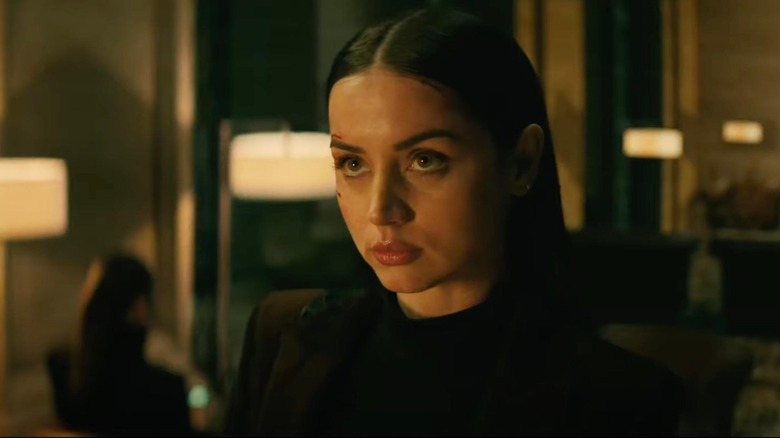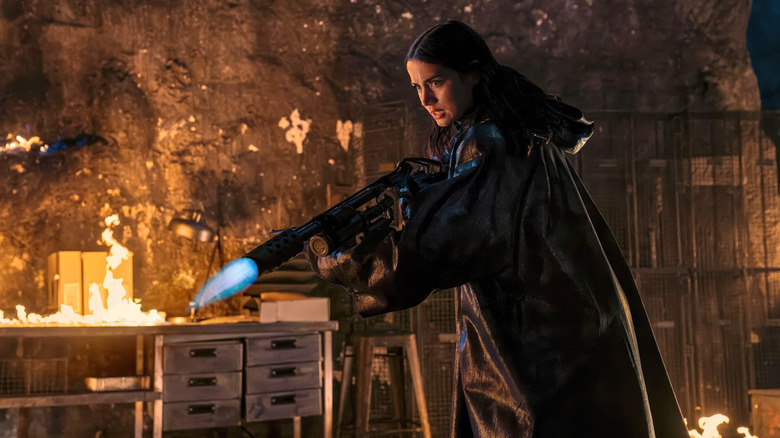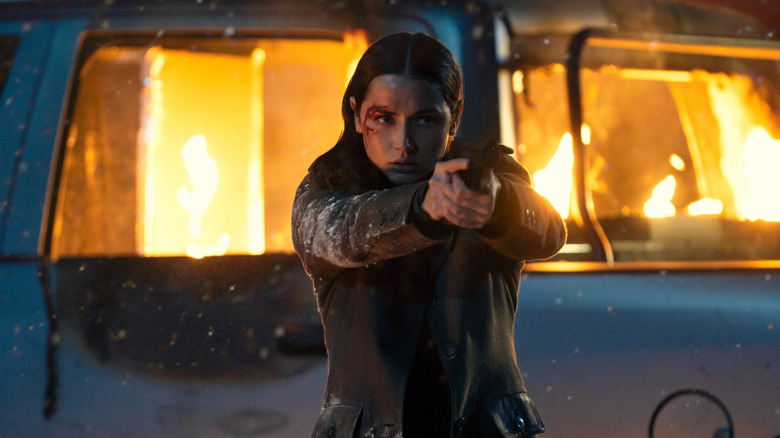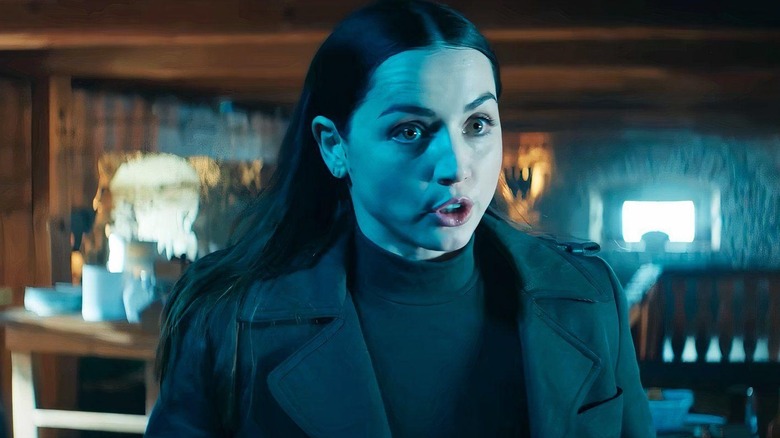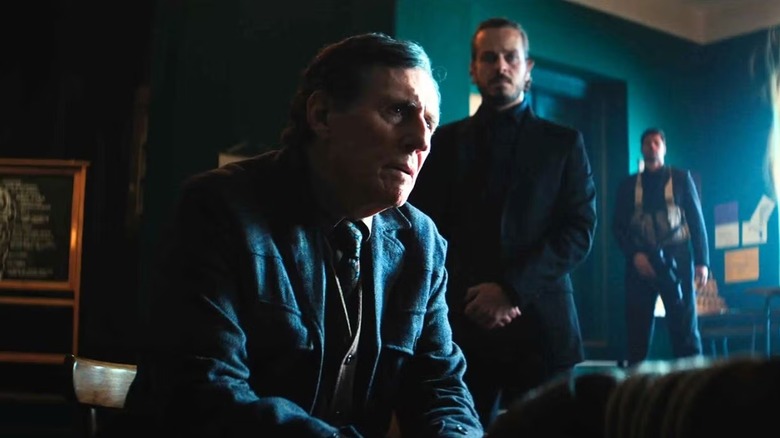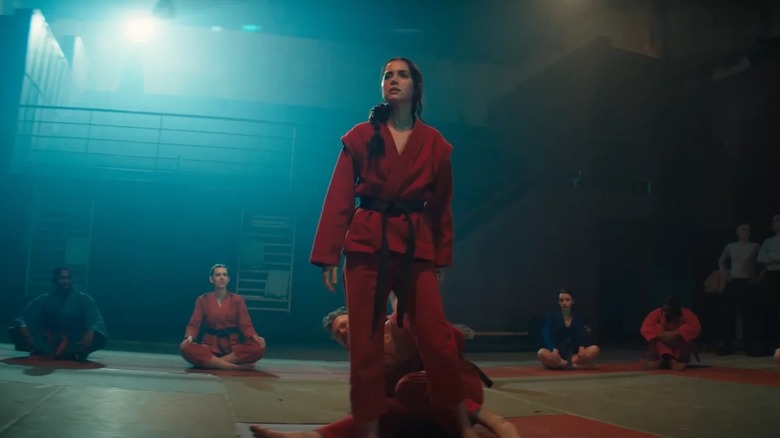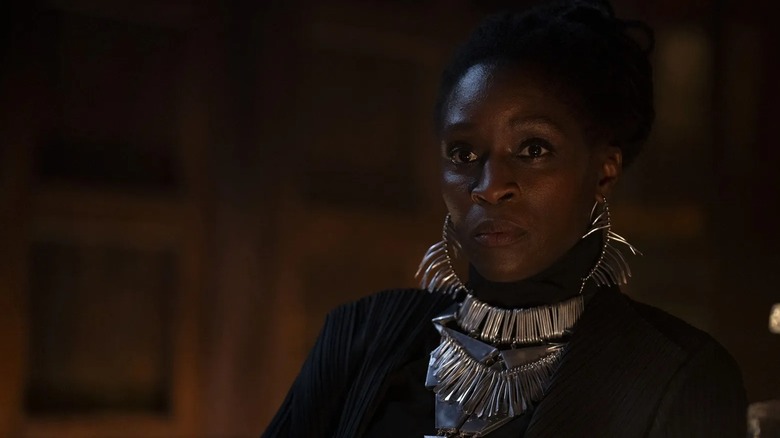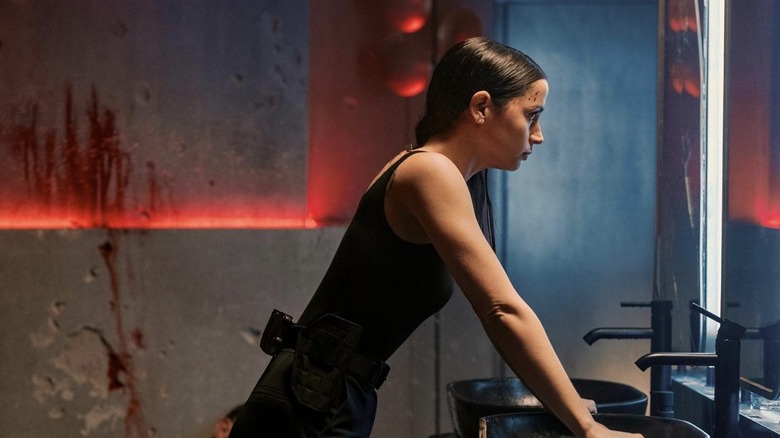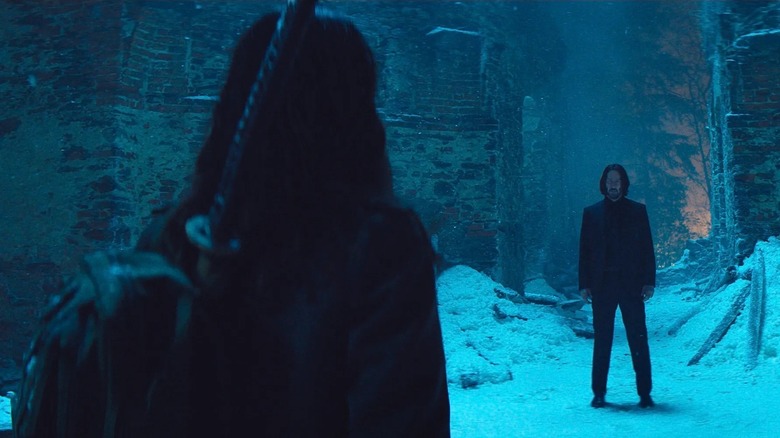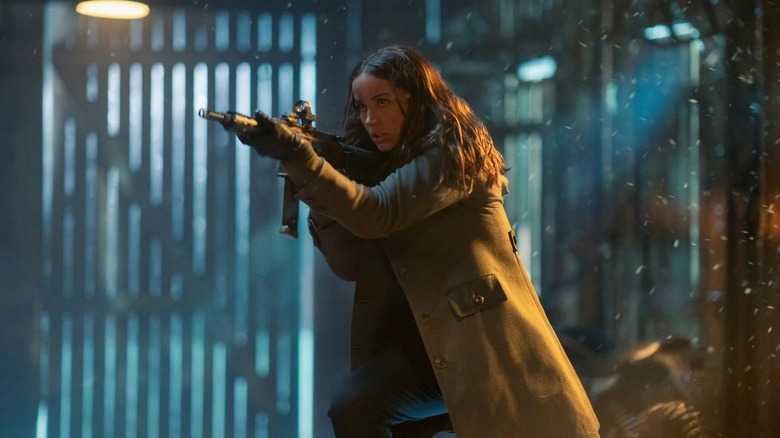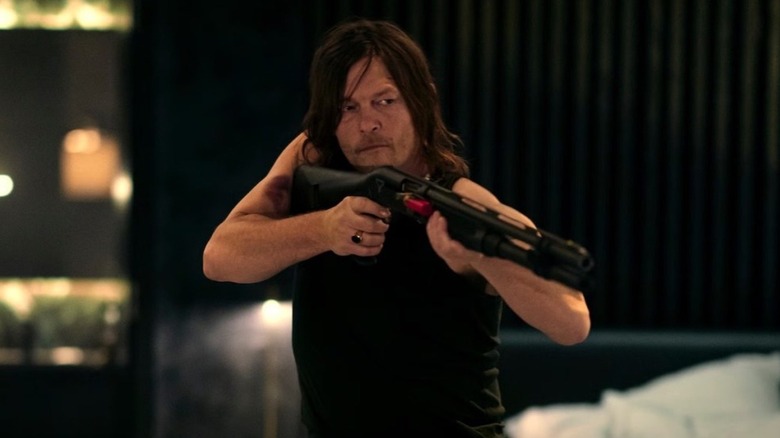Dumb Things We Can't Ignore In The John Wick Spin-Off Ballerina
Contains spoilers for "Ballerina"
While "John Wick" has given us one spin-off TV show, "The Continental," this saga also fully embraces theatrically-released off-shoots of those beloved action films with "From the World of John Wick: Ballerina." Written by go-to "John Wick" screenwriter Shay Hatten and directed by Len Wiseman, "Ballerina" follows Eve Macarro (Ana de Armas) as she trains as an assassin under the guidance of New York-based figure The Director (Anjelica Huston). Rather than just following the orders of her superiors, though, Macarro harbors a desire to exact grisly vengeance on the elusive Chancellor (Gabriel Byrne) who killed her father when she was a child. This sets in motion a classic "John Wick-"style revenge mission that does have some involving and creative action beats. Centering the whole production around the talents of Ana de Armas also lends some welcome gravity to the proceedings.
However, "Ballerina" is ultimately unsatisfying because it gets too bogged down in a convoluted narrative. Rather than being a sleek, succinct display of memorable brawls, "Ballerina" is obsessed with a sometimes labyrinthine story crammed full of elements so dumb they distract viewers rather than captivating them. These silly moments relate to everything from how classic "John Wick" lore manifests in the runtime to unresolved plot threads and character beats underserved by "Ballerina's" overstuffed script. Grab your special coins and load up your guns — it's time to break down the endless obtuse shortcomings that keep "Ballerina" from staying on target as an action movie.
John Wick's cameo makes no sense with the franchises timeline
Early in "Ballerina," the paths of Eva Macarro and John Wick first cross when the former trainee catches the assassin talking to The Director in a conversation lifted from "John Wick: Chapter 3 – Parabellum." Afterward, the duo has a brief exchange before Wick leaves for the rest of "Parabellum's" plot. That all makes reasonable sense in terms of how "Ballerina" can co-exist with "Parabellum." However, the entire trilogy of original "John Wick" movies, including the globe-trotting "Parabellum," take place across just under two weeks. That includes "Parabellum's" conclusion, where Wick fakes his death after falling from The Continental's rooftop and then is retrieved by The Bowery King, who inquires if Wick wants revenge. That tees up "Chapter 4" nicely for his vengeful spree against The High Table, but that finale ensures that Wick's lengthier subsequent "Ballerina" cameo doesn't make much sense.
Given that "Ballerina's" two-month-long time jump occurs after Macarro and Wick's first exchange, the two characters' reunion in Snowy Prague clearly happens after "Parabellum." Once that film's finished, Wick is supposed to be healing and hiding so that he can use the element of surprise to stop his opponents. What on Earth is he doing just taking assignments for The Director (with whom he didn't have any debts to repay after "Parabellum") and hopping aboard trains like a normal guy? While his presence gives "Ballerina" a buzzy cameo, it doesn't make any sense in the "John Wick" timeline.
The big secret sister twist
Generously, the Chancellor's right-hand assassin Lena (Catalina Sandino Moreno) has maybe five minutes of screentime before her greater importance to the plot is realized. Initially, she looks like this movie's equivalent of 007 figures like Jaws or Tee Hee, a striking secondary villain. However, it turns out she's Macarro's older sister. It's a revelation that "Ballerina" plays off as a grand dramatic twist, since now the film's hero and antagonist have an unexpected connection. However, it just comes off clunky in execution. Lena's barely been on-screen up to this point, so hammering home her familial bond with Macarro is abrupt more than anything else. After this, Lena chases and fights Macarro in a cabin before the duo have a quick conversation about how Lena feels her sibling abandoned her. That's the last moment of bonding they get, since the Chancellor orders the cabin to be fired upon, resulting in Lena's death.
Too much has happened to Lena in such a short time between the "I am your sister" reveal and her "tragic" death at the hands of her superior. This means none of the dramatic impulses involving Lena really resonate with the viewer, especially since she didn't have much in the way of either emotional urgency or cool stuntwork to make her memorable. Ultimately, Lena's presence in the film proves superfluous. In the context of "Ballerina" as an entire feature, this sisterly twist comes off as a baffling and inert detour.
The lack of urgency over a kidnapped child
Midway through "Ballerina," Eva's revenge mission gets complicated when her intended interrogation target Daniel Pine (Norman Reedus) actually has a daughter. Much like Michael Shannon's papa in "Midnight Special," Pine is determined to protect his offspring from the clutches of a nasty cult. That daughter is Ella Pine (Ava McCarthy), who is eventually kidnapped by the Chancellor and his minions once Daniel is subdued. In typical summer blockbusters, a precocious youngster getting snagged by the main villains would be the primary driving force of the entire plot. Instead, Eva and the rest of "Ballerina" forget all about Ella for long stretches of time. Save for one scene where the Chancellor has a brief heart-to-heart with the girl, Ella is totally absent from "Ballerina" until the finale. Even here, her presence is awkward and feels shoehorned in.
Ella's "Ballerina" screentime isn't just puzzling because of its fleeting nature. It's also odd because it's such a heavy plot detail to linger on and then not emphasize. Right after Ella's kidnapping, Eva goes to find more information about the Chancellor's cult and never once mentions the ticking clock of also trying to save a child during her revenge mission. The subsequent nonchalance about child endangerment just feels so odd, especially as "Ballerina" keeps introducing new, entirely separate forms of conflict. It's another dumb "Ballerina" element suffering from how tremendously busy this screenplay is. With a more streamlined narrative, Ella's plight could've carried actual urgency.
The darker implications of The Director's mission go unresolved
In one of Eve Macarro's final scenes before "Ballerina" sends her out into the world as an assassin, the budding killer is set in an interrogation room with only a table and a dismantled gun in front of her. Also in the room is another lady (who has her own gun to assemble), bruised and clearly irritated about being used as a training plot. When Macarro asks about her identity, the woman responds that she's Macarro "but in ten years." Her few comments afterward indicate that The Director's whole operation will just chew up and spit out Macarro. The two then race to put together their weapons and shoot their opponent, with Macarro winning the day. This sequence suggests that, much like the four "John Wick" movies saw that titular assassin growing disillusioned with The High Table, Macarro too will come to realize the underlying evil of her superiors.
While Macarro does goes rogue from The Director to exact vengeance, that's more because The Director tells her not to threaten old treaties rather than specifically despising the entire world this powerful woman benefits from. It's yet another peculiar "Ballerina" element left dangling in the wind as director Len Wiseman keeps shifting his attention to new storytelling elements. The darker possibilities of Macarro working for an institution that will one day abandon her was too grim for a movie itching to get to all the grenade and flamethrower-oriented fight sequences.
Gabriel Byrne's Chancellor's erratic obsession with fate
Audiences first meet "Ballerina" foe Chancellor in an opening flashback sequence depicting Eve Macarro's father getting murdered by the cult leader and his loyal men. In this sequence, the Chancellor waxes poetic on the nature of fate. Everything is inevitable in this man's eyes. That includes Macarro's dad being discovered by the cult and the Chancellor coming out victorious in the end. Emphasizing so much of his introductory dialogue around the concept of destiny and pre-determined roads suggests that these will be core concepts for "Ballerina's" antagonist going forward. Instead, possessiveness defines the Chancellor more than anything else. His dialogue could belong to any ideologically-positioned villain. Fate doesn't really creep into his verbiage until his final scene against Macarro, where his whole ideology is shattered once Macarro unexpectedly pulls the trigger on him.
Because the Chancellor is so separated from Macarro for the majority of "Ballerina's" runtime, there aren't a lot of dialogue-heavy sequences for his fate-oriented ideology to resurface. Still, it's baffling how "Ballerina" drops this personality trait for nearly the entire runtime after a prologue solely defining the Chancellor by his obsession with everything in life being prearranged. Jostling between that personality and his vaguely evil aura leaves the figure erratically defined and undercooked. It also accentuates how disconnected that kick-off scene feels from the rest of the film. "Miller's Crossing" leading man Gabriel Byrne deserved a more consistent character to play.
The terrible de-aging in the prologue
"Ballerina" begins with a flashback set 12 years prior to the main story as a young Eve Macarro witnesses her father's demise. After this, Macarro is greeted by familiar "John Wick" face Winston (Ian McShane), who offers the young girl a choice to either pursue a normal life or become an assassin. Occuring over a decade before audiences first see him in 2014's "John Wick," "Ballerina's" prologue features a younger version of Winston. Because of that, some distracting digital de-aging was used on McShane for this sequence. Whatever technology was deployed for this early stretch of "Ballerina", Winston looks distractingly plastic and artificial as the narrative hits the ground running. A reliable authority figure in past "John Wick" installments now looks too much like a video game character who wandered aimlessly into the real world.
It's a weird touch on multiple levels, including how it directly conflicts with the grimy believability of past "John Wick" titles. Maximalist sylishness permeates this franchise, but always in a practical fashion, particularly in the costumes and sets. Using digital de-aging on McShane directly undercuts that ethos in addition to just looking terrible on its own merits. Winston's dialogue to Macarro is very low-key and intimate, which is hard to absorb when the character's lip movements look off. This "Ballerina" prologue misfires on many creative levels, but it's especially poor considering the way its digital technology mangles Ian McShane.
Hello and goodbye, Nogi
Though The Director is Macarro's highest-ranking superior, the authority figure audiences see Macarro most bonding with is Nogi (Sharon Duncan-Brewster). Adorned with an elaborate necklace and a profoundly assured attitude, Nogi is the person who inspires Macarro to fight ferally in hand-to-hand combat and even provides words of reassurance when times get tough. For "Ballerina's" first act, Nogi is a ceaseless on-screen presence and the closest thing Macarro has to a constant ally within the walls of the ballerina/assassin training studio. However, once Macarro goes rogue, Nogi vanishes. Her last appearance in "Ballerina" sees her objecting to The Director putting out a hit on Macarro. Afterward, she's gone, and doesn't even get to return for the feature's final epilogue when Macarro briefly returns home to New York City.
It's incredibly dumb for Nogi to disappear like that after getting so much screentime, especially since Duncan-Brewster is so impactful in the role that her absence is profoundly felt. Considering "Ballerina's" epilogue makes sure to pay off players from earlier in the runtime like Tatiana (Juliet Doherty), Nogi's abrupt vanishing is even more egregious. Plus, having Nogi around in some capacity for "Ballerina's" home stretch would've given Macarro a post-first-act dynamic with another lady character, which would've been a tremendous boon to the entire film. There are just endless problems with how "Ballerina" tosses aside Nogi after emphasizing her importance.
Those multiple first act time jumps
"John Wick: Chapter 3 – Parabellum" hits the ground running, literally. At the start of that film, John Wick and his pitbull companion are dashing through the streets of New York, trying to make every second count before the clock strikes 12 and every assassin will be after him. Each of the "John Wick" sequels immediately launches in a propulsive fashion. The individual stories and action spectacle are apparent from the get-go and then never cease. One of the many dopey aspects of "Ballerina's" script is how it eschews the rapid-fire narrative approach of its predecessors for a more beleabored, expansive storytelling canvas. Shay Hatten's screenplay begins with two separate time-jumps within the first 30 minutes. The entire story's opening concerns Macarro as a child witnessing her father's death before committing to becoming an assassin. This inspires the first time-jump when viewers are pulled forward 12 years in time to Macarro training as an adult.
Soon after that, "Ballerina" once again tiptoes forward in time to two months later, after Macarro has done several assassin assignments and become an expert killer. There's a frustrating lack of compactness in this strained narrative approach. It takes forever to get Macarro to her efficient, killing machine state. Save for adolescent Macarro witnessing her dad's death, little is gleaned by spending so long in yesteryear. Even without superior, better-paced "John Wick" sequels to compare it to, these constant "Ballerina" time-jumps would still be an extremely witless decision.
The awkwardness of the John Wick vs. Eve fight
"Ballerina's" third act eventually grinds to a halt so that Keanu Reeves can show up for his second John Wick appearance. Called upon by The Director to stop Eve Macarro's vengeance-fueled rampage, the two meet in an isolated snowy realm, where Wick tries to tell her to walk away from this thing. Macarro isn't abandoning avenging her father, though, and an inevitable fight scene between the two "John Wick" saga leads ensues. Pitting the first "John Wick" spin-off protagonist against the original franchise lead must've sounded like a divine proposition to some Lionsgate executives. However, this awkward set piece instead drags up memories of how Dwayne Johnson and Jason Statham allegedly have it in their respective contracts that they can't lose on-screen fight scenes.
Here in "Ballerina," Wick and Macarro trade some gunfire, scuffle on the ground, all while Wick constantly tells her to "leave." These little exclamations from the weary, older assassin do benefit from Reeves having great comic timing. However, the whole sequence's redundancy comes through in how it's clear "Ballerina" doesn't want to show either character "winning" or "losing." To do so would dilute the importance of Macarro and Wick's solo movies, after all. Thus, the entire sequence fails to offer much spectacle or dramatic tension. All it accomplishes is distracting from Macarro's brutal operation to remind people of older "John Wick" films. A clash of action cinema titans is instead a vapid piece of fan service.
One gun supplier apparently knows all
Right after Ella's kidnapping, Eve Macarro pays a visit to a Prague arms dealer, Frank (Abraham Popoola), who can give her some valuable guns and intel. He's a new incarnation of "The Sommelier" (Peter Serafinowicz) seen in "John Wick: Chapter 2," an externally dapper gentleman who has enough guns to make Ted Nugent think he's died and gone to Heaven. Even with Frank building on the legacy of a pre-existing "John Wick" figure, though, Shay Hatten's script makes the vacuous decision to turn a visit to Frank's shop into an opportunity to deliver too much exposition at once. At just one location, Macarro discovers so much about the Chancellor's cult, including the mysterious snowy locale they call home. All the mystery surrounding these antagonists gets punctured in just one scene, thanks to Frank's inexplicable, immense knowledge.
Frank only showing up for this scene just makes his immense importance to Macarro's quest extra puzzling while his exceeding helpfulness to Macarro undermines the verbal aloofness of past "John Wick" side characters like "The Sommelier" or "Tick Tock Man." On top of all that, there are no consequences to Frank wielding this knowledge while all this exposition gets clumsily sandwiched in between an abrupt gun store shootout. It's clear "Ballerina" just needed to outline a ton of lore so Macarro could get to the next step of the plot. To accomplish this, "Ballerina" opts for a half-baked gun shop detour that just doesn't work.
Norman Reedus is not dead, he's surely alive
Easily taking the cake for the dumbest scene in "Ballerina" is one of the movie's final moments depicting Ella Pine in a hospital room, right after Eve Macarro rescues her. She's tending to her father, Daniel Pine, who's sitting in a hospital bed and wearily opens his eyes to see his happy child waiting for him. A tender father/daughter reunion ensues. It's a moment sure to inspire viewers everywhere not to cheer, but to throw their hands up in the air in disbelief. Previously in "Ballerina," a groggy Macarro witnessed one of the Chancellor's goons stroll up to an incapacitated Pine and put a couple of bullets into his body. He was clearly as dead as dead can be. Much like a "Monty Python and the Holy Grail" character that got turned into a newt, though, Pine apparently "got better" so that he and Ella could reunite.
It's likely this sudden resurrection only exists because there was nowhere else for poor Ella to go in the story. It wouldn't make sense for Macarro take care of her if she's always being chased by assassins, and "Ballerina" didn't previously establish a safe haven for children that could house the youngster. Still, there had to be a better option than this sweaty, awkward reveal that the clearly dead Daniel Pine was actually fine and dandy. It just further undercuts the tension and stakes of this strange corner of the "John Wick" universe.
